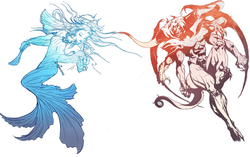Throughout the Final Fantasy series, there have been instances of gods, goddesses and other divine beings. Divine beings often play an active part in the storyline, usually in the role of villain, but on other occasions, the deities are only part of the game's mythology and lore.
Appearances
Final Fantasy
Template:Sideicon When Garland was taken 2000 years into the past by the power of the Four Fiends, he became Chaos and sent the monsters into his former present to create a stable time loop that essentially made him an immortal deity-like being until he is defeated by the Warriors of Light. Melmond has a temple that was destroyed by The Vampire. In the Japanese version, all towns had chapels with a cross on top, showing that the townsfolk might have been Christians.
Final Fantasy II
Template:Sideicon Using dark magic to summon demons to aid in his conquest, the the Emperor of Palamecia splits himself into two beings after his demise. The demonic incarnation takes Pandaemonium as his palace that he raises to the surface to resume his conquest, while his angelic counterpart takes residence in Arubboth. The Emperor ultimately dies on two fronts: his demonic half defeated by the party of Firion, Maria, Guy, and Leon, while his angelic half is defeated by the deceased party of Josef, Scott, Minwu, and Ricard Highwind.
There are buildings in every town called Sanctuaries, indicating religious practise. A statue of an unnamed goddess can be found at Mysidia.
Final Fantasy III
Template:Sideicon The Cloud of Darkness is the entity that returns universes to nothingness.
Final Fantasy IV
Template:Sideicon The summoned beasts are said to be spirits, with Bahamut being the Hallowed Father of all summons.
Final Fantasy IV: The After Years
Template:Sideicon The Creator created the Crystal capable of recording the history of a world and distributed them upon planets that held the promise of life, including the Blue Planet. The Creator, deeming the evolutionary failures of the inhabitants of the Blue Planet can no longer be permitted, sent out the Maenads to retrieve the Crystals in preparation for the merging of the planet with the True Moon.
Final Fantasy VI
Template:Sideicon
The Warring Triad is a trio of divine beings, the source of all magic in the world, and the beings who created the espers. The three are named Demon, Fiend, and Goddess. In ancient times the Warring Triad began to fear each other's power and started the War of the Magi during which they enslaved humans, turning some of them into espers.
When the war ended the gods turned themselves into stone, becoming known as the Statues. The gods' final act was to give the espers their free will and ask them to protect the Statues. The espers fashioned a new realm, where they fled with the Warring Triad's petrified figures. With espers and the Triad gone, magic faded into legend. The Triad was placed in a delicate balance, and it was said catastrophe would occur if they were moved out of position.
A thousand years later, Emperor Gestahl rediscovered magic and invaded the Esper World and raised the Floating Continent with the Warring Triad's power. Kefka seized the Triad's power and moved the Statues out of alignment, shifting the face of the world. Kefka used the power of the Triad to send a ray of energy called the "Light of Judgment" to burn anyone who opposed him, or even entire towns.
When the Returners enter Kefka's Tower they must destroy the Triad to rid Kefka of his power source. However, by this point, Kefka has drained most of the Triad's power into himself and thus, he had become the source of all magic, and in effect, a god himself. After the party defeats him, magic disappears from the world.
Final Fantasy VII
Template:Sideicon
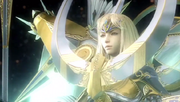
Minerva as she appears in the Lifestream in Crisis Core -Final Fantasy VII-.
Minerva is considered the planet Gaia's goddess, or its consciousness, and a powerful being created by the Lifestream to protect itself. Genesis Rhapsodos believes the "Goddess" mentioned in the poem LOVELESS can cure him of his degradation with her gift, and eventually encounters what appears to be a vision of Minerva in the Lifestream.
A goddess statue (which, however, bears little resemblance to the vision of Minerva Genesis encounters in the Lifestream) can be seen in Banora Underground in Crisis Core -Final Fantasy VII- and in Midgar in Final Fantasy VII: Advent Children.
In a sense, the Lifestream can be thought as the divine power and entity guarding the planet. Sephiroth attempts to merge with the Lifestream to become a god, but is stopped in time.
It appears the world of Final Fantasy VII has little in the way of practised religions, although the nation of Wutai is noted to worship the Water Dragon deity Leviathan. An old church also exists in the Midgar Slums.
Final Fantasy VIII
Template:Sideicon
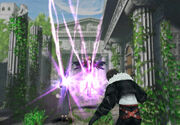
sorceress power has its origins in the Divine.
Hyne is a god in the legends, said to be the origin of the sorceress power. There appears to be no practised religion, and the stories of Hyne appear more as legends and myths told to children. The story of Hyne is that of a god who created the world, and created the humans to help him build it while he would sleep. As Hyne woke up, he realized people had populated the planet in great numbers.
Hyne considered there to be too many people and attempted to reduce their numbers, but the people rebelled and waged war against their creator, and eventually cornered him. Hyne tricked the people by promising them a part of his power, but it turned out the part Hyne had given the people was nothing more than his cast-off skin. Furious, the people searched for the god, but no trace of him could be found.
The Final Fantasy VIII Ultimania Omega contains a short story written by the game's scenario writer, which delves more into the sorceresses' origins. It appears that Hyne, after casting off his skin, divided his being and entered his spirit inside certain human women, as he appeared to feel sympathy toward them as beings that needed protection. These women gained the power to use magic, thus becoming sorceresses. It could thus be said that sorceresses wield divine power that doesn't perish along with the human body, but upon the sorceress's death will seek a new host.
Although there are no churches, and Hyne's name is only mentioned when specifically discussing the mythology surrounding him, characters do use the word "God" as an exclamation.
Final Fantasy IX
Template:Sideicon
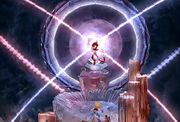
The mother crystal is the source of all life in the universe.
It could be said that the crystal, the origin of all life in the universe, is a divine being. Every planet has its own crystal residing in the planet's core that is the source of all life on the said planet. Planets' crystals can also give birth to powerful beings born of memories of myths and legends, known as eidolons, to protect them.
Kuja travels back in time to the Crystal World and to the beginning of all time in his attempt to destroy the crystal and end the universe. The link between the crystal in Crystal World and the planets' own crystals is unclear, although it could be speculated that the planets' crystals originate from the "mother crystal". Final Fantasy IX Ultimania Omega explains that after the planet's crystal grows old it will die and return to the cosmos, which could mean that all life eventually returns to the mother crystal, the origin of the universe.
After Kuja's attempt to destroy the universe, Necron appears with the intent of reducing all existence into nothingness, or "zero world". It is unclear what sort of being Necron is, as although Necron claims to be eternal, the aforementioned Ultimania explains Necron having been born out of Kuja's will to destroy all existence.
Esto Gaza is a place of worship on the Lost Continent from where the Shimmering Island is visible. As a result, many travel to Esto Gaza on a religious pilgrimage. It is unknown what deity the pilgrims worship, but Shimmering Island's status as the gateway between Terra and Gaia, which causes it to shine when open, is most likely the reason it has gained religious relevance.
Final Fantasy X
Template:Sideicon
The world of Spira practices the religion of Yevon. The teachings of Yevon, a summoner from ancient times, state that the monster Sin is the people's curse for having violated the teachings of Yevon by adopting the use of forbidden machina. The teachings state that through repentance, the people may rid themselves of Sin for good. Most of the world, with the exception of the Al Bhed, follow Yevon, and most towns have a temple.
Within the temples lay the Chamber of the Fayth, which a summoner can approach to gain the power to summon the fayth's aeon. Summoners set out to a pilgrimage to Zanarkand where they obtain the Final Aeon, with which they can attempt to destroy Sin. Yevon teaches that if the people repent enough, Sin won't be reborn.
It is revealed that Yevon is, in fact, the very being that keeps summoning Sin, resulting in its return after each defeat. After Summoner Yuna and her guardians destroy Yu Yevon, Sin disappears for good, but so do aeons, as the dreams of the fayth disperse.
Final Fantasy X-2.5 ~Eien no Daishō~
Template:Sideicon In Besaid Temple in the distant past, the main hall had statues of the gods people worshiped before the time of Yevon: Kush, goddess of food and shelter; Velm, god of safety; Slone, god of quenching regret; Arb, god of knowledge; Luchel; god of War, Kanaela; goddess of protection from darkness; Meiyou, goddess of light; and Guarudo, god of rest.
Final Fantasy XI
Template:Sideicon The creation myth widely accepted in Vana'diel centers around the Dawn Goddess Altana and the Twilight God Promathia. The legend speaks that Altana was the one who created Vana'diel, whereas Promathia had cursed the children of Vana'diel with the flaws they have.
Although the majority of the enlightened races of Vana'diel worship the Goddess Altana, Her followers are generally divided into various orders, such as the Church of San d'Oria, the Church of Tavnazia and the Eimert Church. The beastmen Sahagin also worship the goddess. Promathia is shunned and rarely brought up, if not forgotten entirely. Although he is generally taken to be the patron deity of the beastmen, they do not explicitly worship him. Promathia is mistakenly worshiped by the Moblin, whose true patron deity is Alexander.
Besides Altana and Promathia, there are elemental beings known as the Sleeping Gods that reside in proto-crystals scattered around Vana'diel. While knowledge of their existence is limited, they are typically only revered as entities of great power. The sole exception is the Dark Divinity Odin, who has since been freed from his proto-crystal. Odin counts the Kindred as his followers, as well as the fallen civilization of Ephramad and those who have pledged themselves to be his servants.
There are numerous other religious beliefs in Vana'diel, but not all, such as Talekeeperism and Animitism, make references to divine entities. In the Near East, the people of Aht Urhgan follow the teachings of the great sage Walahra and worship the Serpentking Zahak. The beings known as Cait Sith that adventurers come into contact with during the events of Final Fantasy XI: Wings of the Goddess can be considered as divinity as they are created from the tears of Altana herself.
The rest of the beastmen of Vana'diel worship a diverse pantheon of gods. For instance, the Yagudo Theomilitary worship their leader, the Manifest, and the tonberries worship the disfigured goddess Uggalepih, who may not actually exist given the origins of their kind.
Final Fantasy XII
Template:Sideicon Template:See Also
The Occuria

Gerun, the leader of Occuria.
The Occuria are known as the gods of Ivalice, although the Occuria refer to themselves as either Occuria or Undying. The Occuria watch over Ivalice and attempt to manipulate history by giving power to persons they deem worthy. Among these are those referred to as the "Dynast King", but the Occuria themselves call them "Saints". Following the Occuria's wishes, the Saints set out to wield the magickal power given to them in form of nethicite, and destroy and conquer nations as the Occuria see fit.
One Occuria takes a different route and sets out to free mankind from the Occuria's grasp by teaching people how to manufacture their own nethicite. To fight against this turn of events the Occuria choose Princess Ashe as their new Saint and ask her to destroy the Archadian Empire. Ashe claims she is "no false Saint for them to use", and destroys the Sun-Cryst, the origin of all nethicite and its power, severing the tie between the Occuria and mankind.
The Occuria are also known as the beings who created the Espers, immortal beings who wield great magickal power. As the game's bestiary entries suggest, the Espers in time grew arrogant, believing themselves the greatest force in all the world, and, deeming themselves even greater than the Occuria, set out to wage war with them. The battle was led by the leader of all Espers, the Archangel Ultima. The Espers nonetheless were no match for the Occuria who banished them to the realm of Mist only to manifest in the material world when a summoner would call upon them.
Despite Occuria's immense power and immortality, it is unclear whether they are truly divine, as it appears they used to live on Ivalice, judging by the ruins of Giruvegan they have left behind, and also the fact they are unable to directly influence the mortal world, and only meddle via the intermediary of nethicite. It appears Occuria are intelligent beings able to wield magick who found a way to transcend the material world and now live in a separate plane of existence.
Faram the Father, God of Light
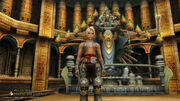
Hall of the Light in Mt Bur-Omisace with a statue of a deity.
The Light of Kiltia was founded by the prophet Kiltia 2000 years ago, and is a polytheist faith system where a pantheon of gods is led by Faram the Father, God of Light. Mt Bur-Omisace is the faith's center, and those who hold to the faith are known as the Kiltias.
Kiltias are known to end their prayers with the name of their deity, Faram, and do the gesture of crossing their arms across their chest. The highest among the ranks of the Light of Kiltia is the Gran Kiltias, who stays in the temple atop Mt Bur-Omisace. The Gran Kiltias is known to be a man of wisdom and deep thought, with possession of powerful magick. The Gran Kiltias at the time of Final Fantasy XII is Gran Kiltias Anastasis.
Final Fantasy XII: Revenant Wings
Template:Sideicon
The aegyl worship the god Feolthanos who is revealed to be a false god who attained immortality by siphoning power from the auraliths. Long ago Feolthanos was a regular aegyl and the leader of the race and had a viera wife and children. Feolthanos revolted against the Occuria, and took his people to Lemurés, using the auraliths, powerful magickal crystals, to lock the sky continent away in Mist. Before sealing Lemurés Feolthanos left behind treasures for his viera children, in the form of auracite and a giant airship, the Galbana, hoping that one day they would be reunited.
When the aegyl settled in the land of Lemurés, Feolthanos wrote the Canon, a book of verse laying down the foundations and principles for the aegyl. He harbored a hatred toward the Occuria and used the auracite to build a palace high in the sky where he absorbed the auracites' power, melding with the auralith to become a god himself. He used the other two auraliths to steal the anima of the rest of the aegyl to make them easier to control. Vaan and his friends defeat him, making him a mortal again. Feolthanos fades away and without him, Lemurés crumbles and falls from the sky.
Final Fantasy XIII
Template:Sideicon Template:See Also
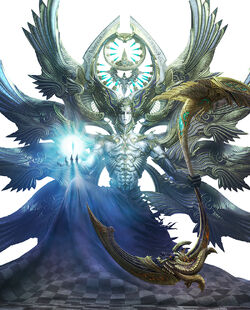
Bhunivelze.
The world of Final Fantasy XIII knows three deities, Hallowed Pulse, Fell Lindzei, and the Goddess Etro. A video of the mythology of the Fabula Nova Crystallis shown at the January 18th 2011 Square Enix Conference reveals a god named Bhunivelze created the three deities to find the door to the unseen realm, where he believes Bhunivelze's defeated mother Mwynn to reside. The gods' true forms are crystals, and they are represented in the official mythology video as symbols.
Pulse created the world of Gran Pulse and the fal'Cie that aid in terraforming the land to find the Door of Souls, which links the living world to the afterlife. Lindzei produced fal'Cie to serve in Bhunivelze's desire to defy death as he entered a deep sleep until the door would be found. Etro, being discarded for her resemblance to Bhunivelze's mother, sacrificed herself, disappearing from the world, and humankind was born out of her blood through Lindzei's power. Etro became the keeper of the Door of Souls, serving to preserve the natural order which Bhunivelze was attempting to disrupt with his fal'Cie.
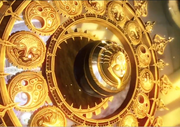
The Lindzei fal'Cie Orphan.
According to legend, Lindzei created Cocoon and tasked fal'Cie with maintaining it and luring humans to live in the paradise. However, both Lindzei and Pulse were gone without a trace, leaving their respective fal'Cie orphaned. Lindzei's fal'Cie devised a plan to mass sacrifice the humans of Cocoon to force Etro's gate to reveal itself to summon back their Maker. This plan needed to involve Pulse's fal'Cie and their chosen human servants, as Lindzei's fal'Cie could not destroy themselves, nor use their own servants against themselves, to destroy their power source Orphan, which would deactivate Cocoon with the resulting crash killing all residents in Cocoon.
Unlike Pulse and Lindzei, Etro appears to be the only deity who still actively influences the world of Final Fantasy XIII; among such measures are the Eidolons, whom she sends to l'Cie involuntarily bound by a Focus to save them from despair. The Gran Pulse legends also recite that it was Etro who stopped Ragnarok during the War of Transgression and later intervened to release Lightning and her allies, save Oerba Yun Fang and Oerba Dia Vanille, from crystal stasis and l'Cie status.
Lightning Returns: Final Fantasy XIII
Template:Sideicon The events of Final Fantasy XIII-2 culminate in Etro's death, creating the unstable reality that Lightning Returns: Final Fantasy XIII takes place in. Bhunivelze was revived and seven days before the end of the world names Lightning as his savior to have her guide the souls of Nova Chrysalia to a new world he is creating for the souls to reside and begin life anew. Upon learning of Bhunivelze's plans for humanity, Lightning defeats the deity and his body is sucked into a new unseen realm with humanity departing to a new world devoid of deities.
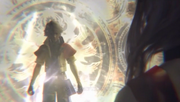
Hope juxtaposed against Bhunivelze's crest.
Bhunivelze is depicted as the God of Light in juxtaposition to the deceased Etro, still known as the Goddess of Death. The two chosen of Bhunivelze, Lightning and Hope, were groomed to become these gods, with Lightning to replace Etro in the new realm, and Hope becoming the vessel for Bhunivelze, his heart inhabiting the god's body. When Hope is possessed by Bhunivelze, he is floating with Bhunivelze's crest behind him so the symbol on the crest's center gives him the god's wings and crown.
Final Fantasy XIV
Template:Sideicon
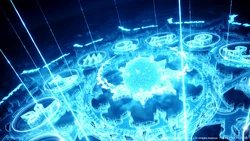
The Twelve attempting to contain the primal Bahamut.
Multiple beings in Eorzea are called or worshiped as deities. The Twelve are benevolent deities who ruled the continent and its surrounding islands until the arrival of wandering tribes. Impressed by the resilience of the primitive settlers, each of the Twelve saw fit to ensure their welfare before departing. They became worshiped by the new residents of Eorzea, becoming patrons of various cities, regions and guilds. The Twelve were summoned by the Elezen mage Louisoix Leveilleur to re-imprison the elder primal Bahamut after he is released from the prison moon Dalamud by the actions of Nael Van Darnus.
As opposed to the new races, the native beastmen of Eorzea worship beings known as the primals (referred to as eikons by the forces of the Garlean Empire), beings sealed away from Eorzea until the death of the dragon Midgardsormr, which broke a seal containing a vast store of aether. This promoted the beastmen to attempt summoning their respective primals, threatening the stability of the land due to the vast amount of energy needed for the summonings.
The Twelve are frequently mentioned or evoked by name, while the primals become enemies that must be defeated by adventurers.
Two other main deities are mentioned, along with sects that worship or work in their name. One deity is the goddess Hydaelyn, referred as the creator of the world, which shares her name. The other deity is called Zodiark, who appears to be a male deity of chaos. His worshipers are the Ascians, a race of ethereal beings who work through other people to ensure the release of their god.
Final Fantasy XV
Template:Sideicon
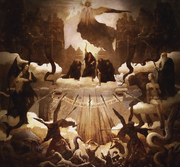
A painting depicting the cosmology of Final Fantasy XV.
When it was known as Final Fantasy Versus XIII, Final Fantasy XV made extensive use of the Fabula Nova Crystallis mythos, including the terminology. By 2015, the use of the mythos had been reduced to an unexpressed thematic base for the game's world. The woman represented in the game's logoFile:Final Fantasy XV Logo.png is the most important goddess in the world's lore: while the world's cosmology is based on Japanese folklore with elements from Western mythology.[1][2][3] The lyrics of "Somnus Nemoris" and "Omnis Lacrima" refer to an unnamed sleeping god waiting for the call to awaken, and calling for aid through his "children".
Archaeans are magical beings said to have been involved in the creation of the world and be tied to the world's deities. The Oracle is said to be able to commune with the gods to hold off the "Plague of the Stars", a phenomenon that causes the nights to lengthen and threatens to plunge the world into eternal darkness.
Final Fantasy Tactics
Template:Sideicon Template:See Also Nearly a century after Final Fantasy XII, a separate Kiltia sect was created by Saint Ajora, with his claiming that Faram was the only one true deity to worship. Saint Ajora was, in fact, a human host for the Esper, or Lucavi as they are known in Final Fantasy Tactics, Ultima. Saint Ajora ended up becoming a prominent figure in the world religion. The Lucavi attempt to resurrect their leader, the Archangel Ultima, by orchestrating the War of the Lions and finding a new host for her.
Two spell quotes from the Black Mage mention two unnamed gods. The quote from the Death spell mentions a death god, and the Flare spell mentions a dark god. Ultima's spell quote for Return mentions the Gods of time and tide.
Although Church of Glabados resembles that of Christianity, it is a polytheistic faith. Tom Slattery, the translator for Final Fantasy Tactics: The War of the Lions, explains it thus:
The whole monotheism/polytheism thing is something I've seen a lot of people mention. The Church of Glabados is clearly modeled around Christianity, and the religion itself would seem to be a monotheistic one. Yet in the very opening scene of the game, Ovelia's prayer mentions "kami-gami" (gods, in the undeniable plural). Since the game's script had made it clear that followers of the world's religion spoke of more than one god, we retained that plurality in the English.
Tom Slattery, translator for Final Fantasy Tactics: The War of the Lions
Time God Zomala
The Time God Zomala is mentioned in Final Fantasy Tactics and Final Fantasy Tactics A2: Grimoire of the Rift. He is a deity whose powers are invoked via a pact made by the summoner. His most notable power is creating dimensional rifts that lead to forbidden places.
In Final Fantasy Tactics, Loffrey Wodring chants a spell involving Zomala, which sends both him and Ramza Beoulve to the Necrohol of Mullonde. In Final Fantasy Tactics A2: Grimoire of the Rift, when Illua is defeated by Clan Gully at the Ruins of Delgantua, she reveals that she has made a pact with the Time God and calling upon an ancient spell, she transports Clan Gully and herself to Zellea, the Forbidden Land.
Final Fantasy Type-0
Template:Sideicon Template:See Also As part of the Fabula Nova Crystallis series, Final Fantasy Type-0 includes parts of its mythos. The characters Arecia Al-Rashia and Gala are affiliated to the deities Pulse and Lindzei respectively. Their affiliations can also be seen in their ways of trying to find Etro's gate: while Arecia tries to use powerful souls to reveal the gate, which becomes known as the legend of Agito, the Judge and his Rursan Reavers try to force the door to manifest by slaughtering the people of Orience.
The fal'Cie also appear in the form of the land's four semi-sentient Crystals, which create l'Cie to protect them and their respective nations. All Orience l'Cie bear the brand of Pulse, further reinforcing Arecia's connection to the god, as she was the one who created them.[5] When Tempus Finis, or the end times, commences, Gala's chosen Judge sets trials for the Crystals' chosen l'Cie to deem their worthiness of being Agito, the soul who can open Etro's gate. If there is no Agito, and the souls released by the Rursus also fail to reveal the gate, the world is destroyed and the spiral started anew.
The Final Fantasy Legend
Template:Sideicon The Creator, God in the Japanese version, is the creator of all the worlds and the Tower. He spread the rumor that Paradise can be found at the top awaiting those who would challenge the Tower. In truth, it is but a game for his entertainment, to see who would attempt and succeed in scaling the Tower's perils; Ashura and the Fiends.
Final Fantasy Legend II
Template:Sideicon The New Gods are beings that have used MAGI to become gods. Ashura was once a humble Goblin before he used the power of MAGI: the race of the other New Gods is unclear. The player characters and Guardians gather the MAGI, but do not use them to their full extent, but they are not considered New Gods.
Three other beings also carry and use MAGI, though they are not identified as New Gods by the Guardians: Ki was born with MAGI in her body and uses them inadvertently to heal others. The robot Dunatis is called a god, but not a "New God". Lastly, the mysterious Magnate is unknown to the Guardians until he appears before the party and Taro. Alongside Dunatis, Apollo's World has rumors of a god named "Neptune", but the party discovers that acts attributed to this "god" are actually the fault of the Undersea Volcano.
The MAGI itself is the remains of a statue of the Goddess Isis, who is an "Ancient" and claims not to be god, throwing the divinity of the New Gods into question.
Final Fantasy Legend III
Template:Sideicon The Masters are "Gods" in the sense of the Cthulhu Mythos, which inspired them. They rule the Purelanders. Sol (called "God" in the Japanese version) is among their number: he is said to have created the player character's world and also the Talon.
Vagrant Story
Template:Sideicon Template:See Also The nation of Valendia introduces the faith of St. Iocus and a long forgotten branch of Kiltia led by the enchantress and dancer Müllenkamp. Over two millennia ago, Müllenkamp of Kiltia established a city for her followers, known as Leá Monde, and used it as a stronghold while she wove spells into grimoires and enticed demons to learn of the powers of the Dark.
The power of the Dark grants the wielder many abilities, such as the use of magic, the power to summon monsters, and the awakening of psychic powers on the spiritual level, from casting illusions, controlling minds, to clairvoyance and reading the depths of one's heart. Those who die bathed in its influence are subjected to a theological limbo for all eternity unable to pass into the afterlife and forced to remain in the world, while absorbed into the Dark's collective of souls and left in emotional torment as a formless and forever lost spirit.
The Church of St. Iocus is a faith not unlike St. Glabados, that has its roots in Valendia. Identified with a six-lined cross adopted from the faith of Müllenkamp, known as the Holy Rood, it establishes itself as a monotheistic faith that condemns the use of magic throughout Valendia. Although its influence has spread throughout the nation, even to the city of Leá Monde, it nonetheless uses its banishment of magical arts as covert means to gain the powers of the Dark to attain immortality for the faith's Cardinal, and possibly, to use as a potential weapon.
Dissidia Final Fantasy and Dissidia 012 Final Fantasy
Template:Sideicon Template:Sideicon
World B, an alternate dimension to World A, the world of the original Final Fantasy, knows two gods: the God of Discord, Chaos, and the Goddess of Harmony, Cosmos. The two are actually perfected manikins, artificial beings created from crystal ore originating from the Rift that ended up in World A.
While Chaos was the product of multiple memories in one hideous body, Cosmos was a duplicate of Cid of the Lufaine's wife who was created by the military as an alternate means to soothe Chaos. Cid explains that it was the summoned warriors (likely the generation of Shantotto, Prishe, and Gabranth) who dubbed the cycle "the conflict of the Gods".
After they end up in World B as the result of Chaos unleashing his powers and opening a portal to World B, Cid makes a bargain with Shinryu to devise a means to return to their world. Becoming the bodiless "Great Will", Cid oversees the endless conflict between the warriors Cosmos and Chaos summon from other worlds to battle for them, while Shinryu revives the fallen warriors after every subsequent war with the losing group losing all memories of themselves and past cycles of conflict. Deciding to put an end to the conflict after eleven cycles, Cosmos places her power within her warriors and sends them on a quest that would manifest the power into crystals.
Despite the manikins' introduction to the war, and losing a number of her warriors as a result, Cosmos's plan succeeds in the thirteenth and final cycle. It leaves Cosmos weakened and it gives Chaos the chance to destroy her. As the world begins to crumble, the heroes remain in the world due to the crystals, giving them the chance to kill Chaos for good. After Garland is sent back in time to restart the cycle from this position, Chaos is overwhelmed as he regains the lost memories of his life in World A, giving him true understanding of the cycle of war.
Shinryu gives him the power to end the cycle in his victory, and purge all existence. In the final battle, Chaos is defeated, and the warriors of Cosmos return to their worlds as the god is consumed in fire. Cosmos also survives, and intends to remain in World B even as it begins to fade out of existence.
References
- ↑ http://www.finaland.com/?rub=site&page=news&id=5516
- ↑ 『ファイナルファンタジーXV』発売時期を示唆、『Just Cause 3』との技術協力も決定【gamescom 2015】 QUOTE:
――ではもうひとつ。神話や神についての設定は、『FFヴェルサスXIII』から『FFXV』への移行により変更があるのでしょうか。
田畑: 『FFXV』にする段階で、そこまでに固まっていた設定については、神話とは強く絡めず『FFXV』の設定として取り込んでいます。ファブラの神話として出てくるものではありませんが、ベースとして活きています。 - ↑ http://www.gamespot.com/articles/16-more-things-we-learned-about-final-fantasy-15/1100-6430160/
- ↑ http://www.rpgamer.com/features/insidegaming/tslatteryint.html
- ↑ http://type0.haloandwingsstudio.com/tabata/
Template:Recurring Elements



